Pinion angle is the angular relationship between a vehicle’s driveshaft and rear differential pinion. It is a critical factor affecting driveline performance and is key to minimizing driveline vibrations, reducing premature drivetrain wear, and ensuring optimal vehicle drivability.
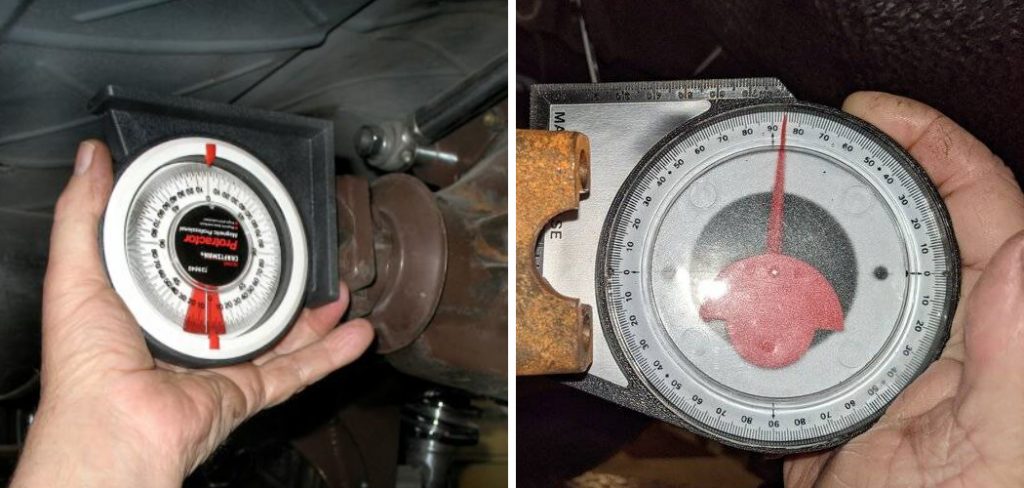
Understanding how to measure pinion angle is essential for anyone looking to maintain or modify their vehicle’s suspension, especially after lifting or altering the ride height. This introduction will outline various techniques—including the basic one-angle, two-angle, and advanced inclination gauge methods—each with unique advantages and challenges to effectively provide you with a comprehensive approach to pinion angle.
Understanding Driveline Angles
Driveline angles are crucial in the seamless operation of a vehicle’s drivetrain. They refer to the angles formed by the driveshaft—the component that transmits power from the engine to the wheels—and the pinion, which is part of the differential at the vehicle’s rear. Specifically, the driveshaft angle is the inclination of the driveshaft in relation to a horizontal plane.
In contrast, the pinion angle refers to the tilt of the differential’s input flange where the driveshaft connects. These angles must be finely tuned, as they directly influence how power is delivered to the wheels, and an incorrect angle can cause undue stress on the components and lead to vibrations that affect ride quality.
An ideal pinion angle typically ranges from 0 to 4 degrees, balancing efficient power transfer with minimal wear on universal joints and bearings. By maintaining these optimal parameters, vehicles benefit from smoother driveline operation, prolonged life of drivetrain components, and an overall enhanced driving experience.
Why Measure Pinion Angle?
Measuring the pinion angle is fundamental for anyone committed to maintaining their vehicle’s driveline health. Key benefits include:
- Troubleshooting Driveline Vibrations and Noises: Unusual vibrations or sounds emanating from a vehicle’s undercarriage often signal a misaligned pinion angle. These issues can be promptly diagnosed and rectified by measuring and adjusting the angle accordingly, leading to a quieter and smoother ride.
- Verifying Proper Suspension Setup After Modifications: Modifications such as lifting or lowering a vehicle can disrupt the original driveline geometry. Measuring the pinion angle ensures that any changes in suspension setup do not negatively impact the driveline, preserving the integrity of the vehicle’s performance.
- Selecting the Correct Differential Angle Kit for Lifted Vehicles: A differential angle kit may be necessary to maintain the proper driveline angle for lifted vehicles. Accurate measurement of the pinion angle aids in choosing the right kit to match the vehicle’s altered stance, ensuring a correct fit and function.
- Ensuring Optimal Performance and Longevity of Drivetrain Components: When the pinion angle is set within the manufacturer’s specifications, it facilitates optimal power transfer and reduces strain on the universal joints and bearings. This not only boosts performance but also extends the lifespan of the drivetrain components, making measurement a wise investment in the vehicle’s overall health.
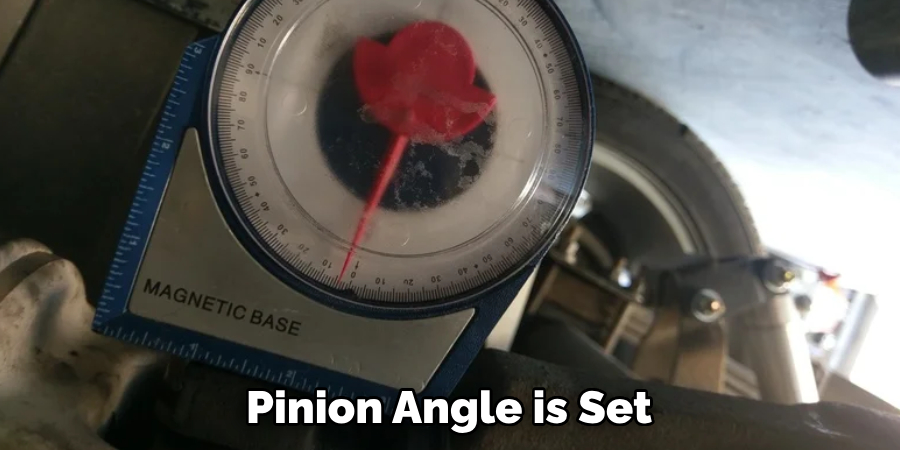
Tools and Preparation
Before you begin measuring the pinion angle, it’s important to assemble the right tools and observe basic safety precautions. Here’s what you’ll need:
- Magnetic Angle Finder: This can be digital or analog, essential for determining precise pinion and driveshaft angle readings.
- Straight Edge or Level: Utilized to provide a reference line for angle measurements.
- Tape Measure: Useful for verifying the distance between components where applicable.
- Jack Stands: Necessary for safely supporting the vehicle at a working height.
- Wheel Chocks: These prevent the vehicle from rolling while you’re working.
- Safety Glasses and Gloves: Always protect your eyes and hands when working under a vehicle.
Basic Safety Precautions
Safety must be your foremost concern. Always work on a level surface to ensure accuracy and reduce the risk of the vehicle moving. Place wheel chocks on the front and rear tires to provide additional stability. Engage the parking brake firmly. When lifting the vehicle, ensure it is properly positioned on the jack stands. Never work under a vehicle that is only supported by a jack. By following these precautions, you’ll create a safer environment that facilitates an accurate measurement of the pinion angle.
How to Measure Pinion Angle: Measurement Methods
Understanding how to measure pinion angle accurately is crucial for ensuring vehicle driveline health and performance. Several methods are available, each with its own level of difficulty and precision. Let’s explore three of these methods to determine which best suits your needs.
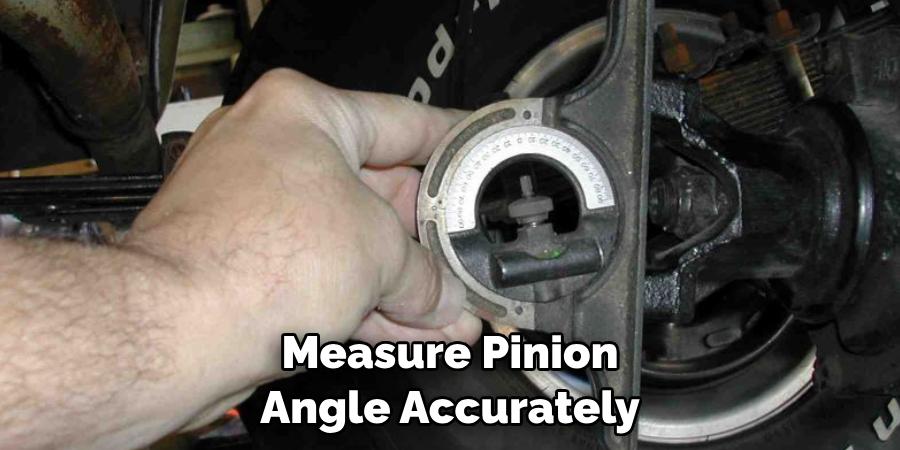
1. Basic One-Angle Method (Easy, Less Accurate)
The Basic One-Angle Method is the simplest way to measure the pinion angle, but it is not as precise as other methods. This approach involves a single-angle measurement at the driveshaft level.
Description
- Uses a single-angle measurement on the driveshaft.
Steps
- Jack up the rear axle until the wheels are off the ground.
- Place the angle finder’s magnetic base on the driveshaft and level the straight edge.
- Record the angle reading.
Pros
- Simple and quick.
- Requires minimal tools.
Cons
- Less accurate, as it doesn’t account for pinion and driveshaft angles separately.
2. Two-Angle Method (More Accurate, Requires Assistant)
The Two-Angle Method offers a more accurate pinion angle measurement by considering the driveshaft and pinion angles independently.
Description
- Measures both driveshaft and pinion angles independently.
Steps
- Perform steps 1-2 from the Basic One-Angle Method.
- With an assistant holding the angle finder on the driveshaft, lower the axle slightly until the driveshaft reaches its natural operating angle.
- Record the new angle reading on the driveshaft.
- Place the angle finder on the differential housing and level the straight edge.
- Record the pinion angle reading.
- Calculate the total pinion angle by subtracting the driveshaft angle from the pinion angle.
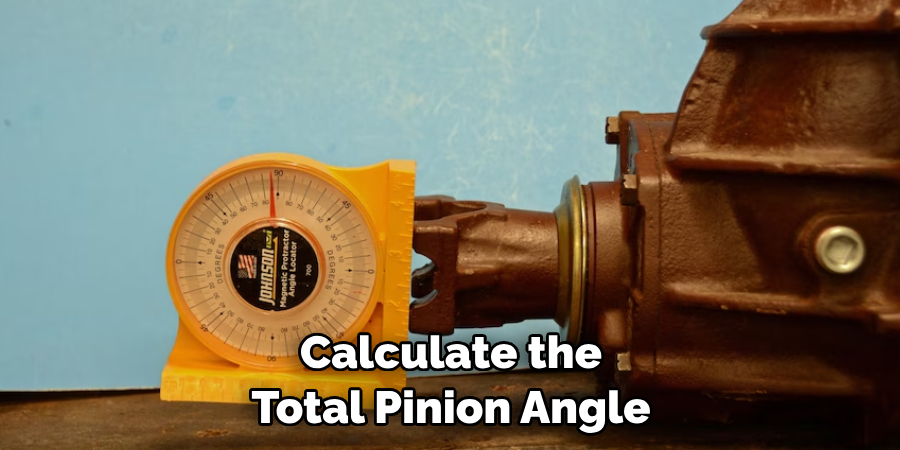
Pros
- More accurate representation of the true pinion angle.
- Considers both angles independently.
Cons
- Requires an assistant.
- Slightly more complex process compared to the Basic One-Angle Method.
3. Advanced Inclination Gauge Method (Most Accurate, Requires Tools)
The Advanced Inclination Gauge Method is the most precise approach, typically used by professionals in a shop setting.
Description
- Utilizes a specialized inclination gauge for precise measurements.
Steps
- Follow steps 1-2 from the Basic One-Angle Method.
- Attach the inclination gauge to the driveshaft and the differential housing using the specific adapters.
- Adjust the gauge according to the manufacturer’s instructions to obtain accurate angle readings.
- Calculate the total pinion angle by subtracting the driveshaft angle from the pinion angle readings provided by the gauge.
Pros
- The most accurate method available.
- Eliminates most human error.
- Suitable for professional settings.
Cons
- Requires specific tools that may be expensive.
- Requires knowledge and experience to use the tools correctly.
The method for measuring pinion angles depends on the desired level of accuracy, the individual’s skill set, and the tools available. Understanding each method’s advantages and limitations is essential before deciding which is best for you. Remember to prioritize safety at all times and consult with a professional if you are unsure about the process.
That’s it! You’ve now learned how to measure pinion angle, ensuring optimal performance and longevity of your vehicle’s drivetrain components. Regularly checking and adjusting the pinion angle as needed is crucial in maintaining a healthy driveline and getting the most out of your vehicle. With the right tools, preparation, and knowledge, you’ll be able to achieve precise measurements that will benefit your vehicle for years to come.
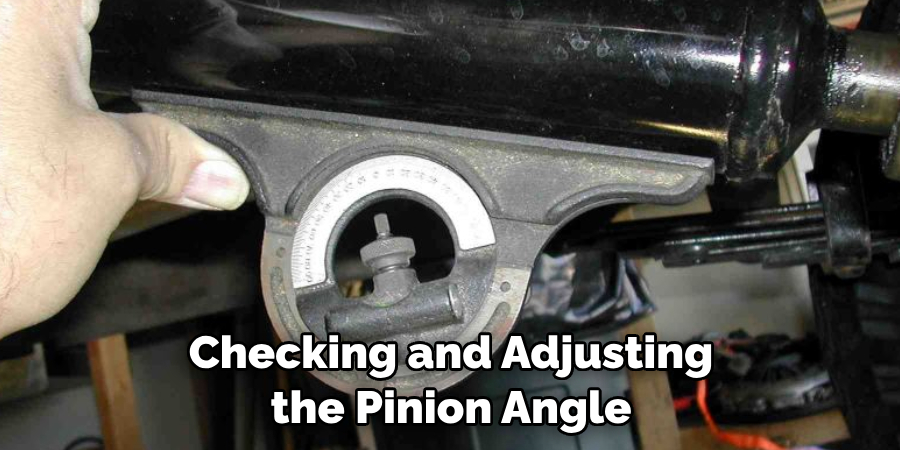
Troubleshooting and Tips
When inconsistencies arise during the measurement of pinion angles, there are several key areas to consider that can affect the outcome.
Common Issues and Solutions
Inaccurate Readings:
- Tool Calibration: Prior to taking measurements, ensure your angle finder is properly calibrated. Many digital models feature a calibration function, while analog devices should be checked on a known level surface.
- Level Surfaces: Verify that the vehicle is situated on a perfectly level surface to avoid erroneous readings. Use a level to gauge the flatness of the area where the vehicle rests.
- Precise Procedures: Follow the outlined steps meticulously. Rushing through or skipping steps can lead to significant errors in measurement.
Difficulty Accessing Components:
- Extensions/Adapters: When space is restricted, use extension arms or adapters to reach confined areas. This ensures that your angle finder has a stable contact point, providing reliable measurements.
- Vehicle Positioning: Sometimes, the difficulty is due to the vehicle’s position. Adjust the height using jack stands or modify the working angle if necessary to better access the measurement points.
Interpreting Results:
- Vehicle Specifications: Consult the vehicle’s service manual for OEM specifications on driveline angles. Compare your findings against these benchmarks to assess whether adjustment is needed.
- Repair Manuals: Repair manuals often contain troubleshooting guides specific to pinion angle issues. They can provide a range of acceptable angles for various load conditions and driving styles.
Additional Tips
- Consistency in Tools: Use the same brand and type of tool for all measurements when comparing angles to minimize variance from differing tool calibrations or scales.
- Check Multiple Points: Measurements should be taken at several points along the driveline to ensure consistency and identify any anomalies.
- Record Your Findings: Keep detailed records of all measurements for future reference and troubleshooting. Note any adjustments made and their impact on driveline angles.
- Invest in Quality Tools: While cutting costs with cheaper tools is tempting, accuracy is paramount in pinion angle measurement. Invest in quality tools that will give precise readings and last longer.
- Understand the Basics: A firm understanding of drivetrain components and their relationship will aid in measuring and interpreting results.
By anticipating potential obstacles and understanding how to navigate them, you will achieve more accurate measurements and improve the performance and longevity of your vehicle’s drivetrain. Remember, measuring the pinion angle is both a science and an art, and with practice; you will become more adept at identifying and solving issues related to driveline geometry.
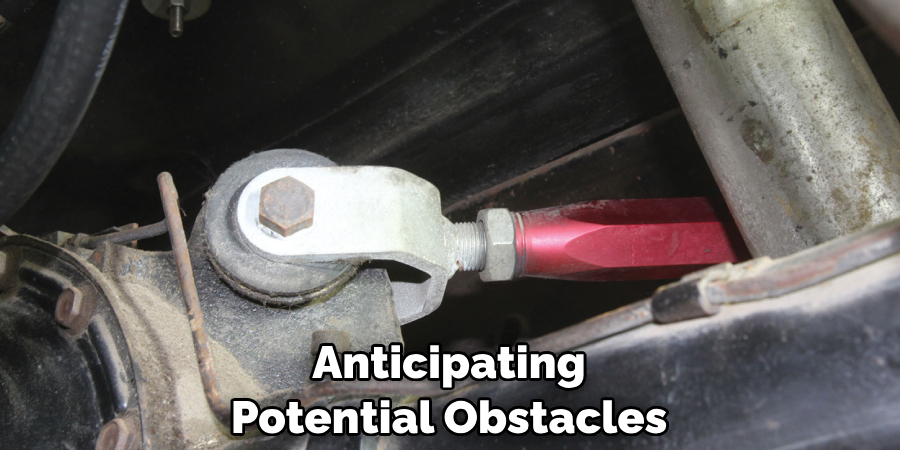
5 Benefits of Measuring Pinion Angle
Whether you’re fine-tuning your muscle car’s suspension or looking to push the limits of your 4×4’s off-road performance, one often-overlooked metric that can significantly impact is your pinion angle.
As vital as it is, getting that perfect pinion angle could make the difference between a ride as smooth as butter and a vehicle constantly fighting against its own design. If you’re an automotive enthusiast or a do-it-yourself mechanic, here are five compelling reasons to measure and adjust your pinion angle.
1. Improved Driveline Performance
Misaligned pinion angles can lead to power loss and unnecessary strain on your drivetrain. When the angles are off, U-joints are forced to operate outside their intended parameters, causing vibrations, increased wear, and decreased performance. A good pinion angle ensures your driveshaft, U-joints, and other components rotate in harmony, translating into superior driveline efficiency and more power reaching the ground.
2. Reduced Wear and Tear
The importance of pinion angle alignment regarding your vehicle’s longevity cannot be overstated. A bad angle means U-joints and CV joints work harder than they should, leading to premature wear on these essential components. By adjusting your pinion angle to manufacturer specifications or within optimal aftermarket ranges, you can significantly extend the life of your drivetrain and save on unnecessary repair costs.
3. Enhanced Handling and Stability
One of the more immediate changes you’ll notice with a proper pinion angle is the difference in how your vehicle handles. Improper angles can lead to a loss of traction, particularly in high-torque applications or off-road scenarios. With a correctly aligned pinion, you’ll experience improved stability, better traction, and more predictable handling, especially when making sharp turns or negotiating difficult terrain.
4. Optimal Power Transfer
Every gearhead knows that power is precious, and power transfer is paramount when it comes to high-performance driving or towing. A pinion angle that’s out of whack can lead to drivetrain binding, where power transmission from the engine to the wheels is inefficient or halted altogether. Correcting your pinion angle ensures that power is optimally transferred without any hitches.

5. Preventing Vibration Issues
Vibrations in automotive mechanics are the telltale sign that something’s wrong. A common cause of these unwanted tremors is a misaligned pinion angle. The vibrations aren’t just annoying; they can signal extensive damage to your drivetrain components over time. By keeping your pinion angle in check, you can minimize these vibrations, providing a smoother and more enjoyable ride for both you and your vehicle.
4 Common Mistakes People Make When Trying to Measure Pinion Angle
Now that you know the significant benefits of measuring pinion angle, let’s look at some common mistakes that can occur when measuring this critical metric.
1. Not Using the Right Tools
One of the most common mistakes people make is using improper tools or relying on their eyesight to gauge pinion angle. As we discussed earlier, having consistency in tools is vital in getting accurate measurements, and eyeballing it just won’t cut it. Invest in a quality angle finder or inclinometer to get precise readings and avoid any guesswork.
2. Neglecting Multiple Measurement Points
Another mistake people make is only measuring one point along the driveline when determining the pinion angle. As we know, slight variances can occur between different points, so it’s essential to take measurements at several points and compare them. This approach ensures accuracy and helps identify any inconsistencies that may need addressing.
3. Not Keeping Records
It’s easy to overlook the importance of keeping detailed records when measuring pinion angle, but this step is crucial for future reference and troubleshooting. Along with recording your initial measurements, make sure to note any adjustments made and their impact on driveline angles. This information will come in handy if you encounter any issues down the road.
4. Lack of Understanding
Finally, one of the most significant mistakes people make is not taking the time to understand the basics of drivetrain components and their relationship. As we’ve learned, having a firm understanding of these concepts is crucial in achieving accurate measurements and making necessary adjustments to maintain optimal performance.

Frequently Asked Questions about Pinion Angle Measurement and Adjustment
What Is a Pinion Angle and Why Is It Important?
A pinion angle refers to the orientation of the differential’s pinion in relation to the driveshaft. It’s crucial for efficient power transfer from the engine to the wheels, ensuring proper alignment of the drivetrain components, which minimizes wear and vibration.
How Often Should the Pinion Angle Be Checked?
It is wise to check the pinion angle whenever you change your vehicle’s suspension or drivetrain. For regular maintenance, checking it once a year or when unusual vibrations occur can prevent larger issues.
Can Improper Pinion Angle Cause Damage to My Vehicle?
Yes, an incorrect pinion angle can lead to excessive wear on U-joints and CV joints, potential damage to the driveshaft and differential, and cause vibrations that can affect overall vehicle performance.
Do I Need Special Tools to Measure Pinion Angle?
While basic tools can help you get a rough estimate, it’s best to use a digital protractor or angle finder that can give precise readings for proper measurement. Investing in quality measuring tools is recommended for best results.
What Is the Ideal Pinion Angle?
The ideal pinion angle varies depending on vehicle specifications, intended use, and the presence of any lift kits or aftermarket modifications. Generally, a slight downward angle of the pinion towards the transmission is optimal but always refer to the OEM specifications or aftermarket guidelines.
How Can I Adjust the Pinion Angle if It’s Incorrect?
Pinion angle adjustments can be made by changing the suspension setup, such as altering the height of the rear suspension, using adjustable control arms, or using shims or angled wedge blocks between the rear axle and leaf springs, depending on the vehicle.
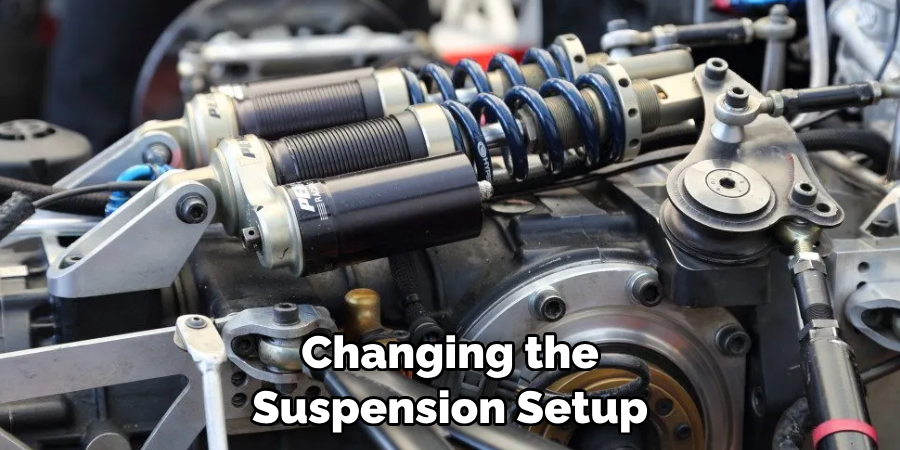
Is It Safe to Drive with A Bad Pinion Angle?
While you might not be at immediate risk, driving with an incorrect pinion angle can eventually lead to drivetrain damage and a rougher ride due to vibrations. Correcting the angle as soon as possible is best to avoid further issues.
Conclusion
In conclusion, understanding how to measure pinion angle is vital for maintaining the integrity and performance of a vehicle’s driveline. Throughout this guide, we’ve explored various methods ranging from the simple One-Angle approach to the advanced Inclination Gauge technique.
Accurate measurements prevent undue stress on components and ensure efficient power transfer from the engine to the wheels. Enthusiasts and professionals can select from the methods that best align with their technical ability and available resources, always prioritizing safety and precision. When in doubt, don’t hesitate to consult a professional to safeguard the longevity and reliability of your vehicle.

Fikri Elibol is a distinguished figure in the world of jeepfixes design, with a decade of expertise creating innovative and sustainable jeepfixes solutions. His professional focus lies in merging traditional craftsmanship with modern manufacturing techniques, fostering designs that are both practical and environmentally conscious. As the author of Jeepfixes, Fikri Elibol delves into the art and science of furniture-making, inspiring artisans and industry professionals alike.
Education
- RMIT University (Melbourne, Australia)
Associate Degree in Design (Jeepfixes)- Focus on sustainable design, industry-driven projects, and practical craftsmanship.
- Gained hands-on experience with traditional and digital manufacturing tools, such as CAD and CNC software.
- Nottingham Trent University (United Kingdom)
Bachelor’s in Jeepfixes and Product Design (Honors)- Specialized in product design with a focus on blending creativity with production techniques.
- Participated in industry projects, working with companies like John Lewis and Vitsoe to gain real-world insights.
Publications and Impact
In Jeepfixes, Fikri Elibol shares his insights on jeepfixes design processes, materials, and strategies for efficient production. His writing bridges the gap between artisan knowledge and modern industry needs, making it a must-read for both budding designers and seasoned professionals.
